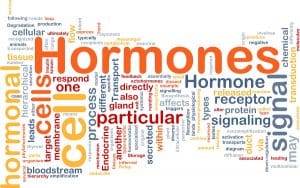The research was presented in a poster session by Saad Sakkal, MD at the May 2014 annual meeting of the American Association of Clinical Endocrinologists (AACE). Before we take a look at the research, let's explain a bit more about the hypothalamus and its impact on weight and metabolism.
What is The Hypothalamus?
Your hypothalamus is an almond-sized part of the brain that connects your nervous system to your endocrine system, with your pituitary gland acting as a go-between. The job of the hypothalamus is to release hormones that then cause the pituitary gland to release (or stop releasing) pituitary hormones. This hormonal process controls the body's temperature, hunger, thirst, fatigue, sleep cycles, and daily cyclical rhythms. Cells in the hypothalamus take up the inactive form of thyroid hormone T4 (thyroxine), and convert the T4 into the active thyroid hormone, T3 (triiodothyronine.) The T3 then stimulates the production of TSH, which then regulates thyroid hormone production.
What is Hypothalamic Obesity Disorder
When the hypothalamus does not function properly — or is damaged in some way (such as after brain surgery) — it can affect your thyroid's ability to take up T4 and convert it to T3. At the same time, hypothalamic obesity disorder can develop. In this situation, your nervous system continues to react as if you are starving, and you continue to gain weight. The weight gain does not respond to even drastic changes in diet or exercise. Hypothalamic dysfunction can also occur in people who have a dysfunction in their leptin and melanocortin systems, which affect appetite, energy expenditure, body temperature, insulin levels, and overall metabolism. Even with severe caloric restriction, if you have hypothalamic obesity disorder, your metabolism is so impaired that it focuses on storing calories, rather than burning them, causing continued weight gain. In hypothalamic obesity disorder, there can also be an overproduction of insulin, which can further contribute to obesity.
More On Dr. Sakkal's Study
The small but groundbreaking study looked at 50 patients who had been evaluated for — and in some cases treated for — the typical symptoms of a hypothyroidism — an underactive thyroid. The study looked for characteristic symptoms of hypothalamic obesity in those patients. These symptoms include fatigue, temperature dysregulation, weight changes, changes in sleeping patterns, pain, and mood disorders. The diagnosis of hypothalamic dysfunction was deemed "likely" if symptoms from three different systems were present and "definite" if present from four or more. According to the researchers, the most prevalent hypothalamic symptoms included:
- Fatigue - 76%
- Temperature dysregulation -68%
- Weight change - 88%
- Changes in sleep - 70%
- Pain - 72% (In particular, trigger point tenderness, which as seen in 68% of the patients)
- Mood disorders - 80%
- Libido issues - 38%
- Sympathetic or parasympathetic complaints - 64%
Overall, 68% of the patients had at least four of the symptoms, and researchers labeled them as having "definite" hypothalamic dysfunction, while 22% had a "likely" hypothalamic dysfunction. Said Dr. Sakkal, "Patients who insist they have thyroid disease causing their weight problems are frequent. Some try thyroid medications, yet they feel worse and don't lose weight. These patients would only benefit from therapy for their hypothalamic dysfunction." According to the researchers, hypothalamic obesity disorder is likely to be an explanation for "thyroid symptoms" in those patients who have normal thyroid tests, or whose thyroid treatment has restored them to "normal" levels. The researchers wrote: "Treating the thyroid in these patients often fails. They need specific therapy for hypothalamic dysfunction based on stress/reward/behavioral therapy, and dual pharmacologic therapy for the dual hypothalamic nuclei pathways affecting satiety/hunger and weight/metabolism."
How is Hypothalamic Obesity Disorder Treated?
In a second poster presentation at the AACE conference, the researchers outlined a combination treatment that included some or all of the following approaches:
- Daily exercise
- A Mediterranean-style diet
- Fluoxetine or bupoprion
- Buspiron
- Trazodone
- Spironolactone
- Topiramate/phentermine
- Testosterone (when levels were low), and bromocriptine (for those with hyperprolactinemia)
The researchers found that, using their approach, over 12 weeks, the patients lost on average about 13 pounds.
Other Approaches to Hypothalamic Obesity Disorder
Holtorf Medical Group has been addressing hypothalamic causes of obesity in patients for a number of years. Typically, thyroid imbalances are thoroughly diagnosed and are not only treated, but optimally treated, which includes addressing low Free T3, elevated Reverse T3, and thyroid transport issues.
In addition, in some cases, injectible drugs like Symlin (pramlintide) and/or Byetta (exenatide) — typically prescribed to help insulin resistance and Type 2 diabetes — are also prescribed, along with HCG, the combination of bupropion and low-dose naltrexone, and in some cases, topiramate.
Sources:
Sakkal S, et al "Why obese patients may have normal thyroid tests despite 'thyroid symptoms'" AACE 2014; Abstract 1974326.
Sakkal S, et al "Successful algorithm to treat hypothalamic obesity disorder" AACE 2014; Abstract 1975922.


